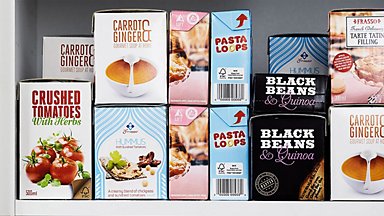Meet the modern packaging solution
The shelf-stable food aisles are changing. What was once home almost exclusively to metal cans and glass jars is now seeing more and more of a modern alternative – the carton. Tetra Recart® is an increasingly popular choice, so why should you choose this package instead of a can?
The reduced environmental impact of
Tetra Recart
Did you know that carbon emissions from Tetra Recart are 85% lower1 than those of steel cans over the lifetime of the respective packages? In addition, our cartons consume only around 40% of the energy1 that cans use during manufacturing, distribution and waste management. When there are billions of packages produced every single year, a shift to cartons can make a real difference. That’s not where the environmental benefits end either, as Javier Conde Alcalá, Tetra Recart Retail Manager at Tetra Pak, explains:
“It’s also about renewability. The only part of a can that’s renewable is the label, whereas up to 71%2 of Tetra Recart is renewable as that’s the paper content. When it’s responsibly sourced, this is material that can basically grow back again."

“When it’s responsibly sourced, this is material that can basically grow back again.”
Enhanced flexibility with the range of package sizes
The ability to make production more flexible is a benefit for everyone. For brands, co-packers and producers it offers an easy way to offer a bigger range of products, potentially appealing to a wider audience. For consumers, it means more choice, and more chance to find the ideal product for their needs. It’s even better if changing between sizes during production is straightforward, as it reduces unnecessary downtime.
“It can take as little as 30 minutes to change between Tetra Recart package sizes,” says Alcalá, “and there are six formats to choose from in total ranging from 100 ml up to 500 ml.”

“It can take as little as 30 minutes to change between Tetra Recart package sizes.”
Space efficiency that offers significant savings
The classic shape of cans is a familiar sight, but it’s not actually very space efficient. They are the same size whether empty or filled, and the rounded nature means that even when they’re packed tightly together, a significant amount of air is shipped due to unused space around the sides. With Tetra Recart, the opposite is true.
“When you receive Tetra Recart from our factory, it arrives as flat paper sheets, so it only takes one truck load of our empty packages to deliver the equivalent of nine trucks of cans,” adds Alcalá. “Then you can ship 10 to 15% more filled packages3 per truck as the square shape means they fit together with no air in between, and it’s quicker to restock and replenish our packages on the shelves. If you sum up the whole value chain, the shape offers savings from the very beginning – from the moment the empty packaging leaves our factory to the time it’s recycled.”

“If you sum up the whole value chain, the shape offers savings from the very beginning – from the moment the empty packaging leaves our factory to the time it’s recycled.”
Improved consumer convenience
“For consumers, the logistics benefits carry through to the home,” says Alcalá. “Tetra Recart is more efficient in storage, easy to open, easy to sort, easy to use, easy to flatten, easy to dispose of, easy to empty. It’s an easier package to live with.”
Part of this is because of the low weight of our solution. It’s around 17g, whereas cans are around 50g. This may not sound like much, but with multiple packages in a single shopping trip, the weight can soon add up.
“If you take five cans in a bag, and five Tetra Recart in another, our solution is much lighter and more space efficient,” Alcalá adds. “There’s also no risk of cutting when a consumer opens Tetra Recart, which can be an issue with cans.”

“If you take five cans in a bag, and five Tetra Recart in another, our solution is much lighter and more space efficient.”
Less waste and reduced waste handling
Tetra Recart reduces waste in a number of ways. One aspect is tied to the lower weight – as the packaging is lighter, there’s less total material to handle and dispose of for the same number of packages. Then there’s secondary packaging – cans tend to be wrapped in plastic, whereas Tetra Recart comes in cardboard trays. But because of the rugged construction, there’s less product wastage in storage and in-store, too.
“The robustness has a big impact for retailers as there’s a lot of waste when cans and jars are dropped, as they often dent or break which means they can’t be sold. This takes away from the margins,” explains Alcalá. “If Tetra Recart is dropped, it’s still likely to be purchased by a consumer.”
Studies carried out at supermarkets in Sweden and the UK have actually shown that waste due to damaged and unsellable packages is up to 80% lower for Tetra Recart compared with cans, which can reduce waste while improving profitability.

“If Tetra Recart is dropped, it’s still likely to be purchased by a consumer.”
Cartons come out on top
From the environmental benefits to the improved consumer experience, there are many reasons to choose Tetra Recart over cans. It’s the game-changing solution for food, and we’re here to help you make the most of it. Get in touch to find out more.

1. LCA report, 2020, European market
2. Carton CO2 Calculator certified by the Carbon Trust.
3. Based on internal simulations comparing Tetra Recart to cans and jars of equivalent sizes.



